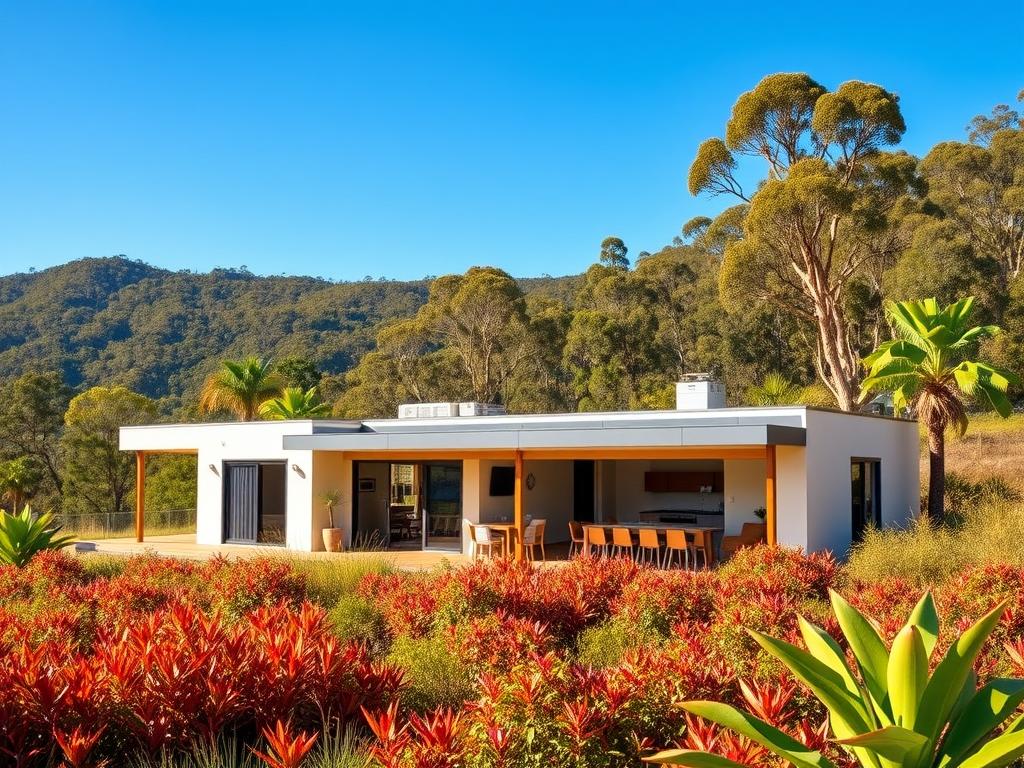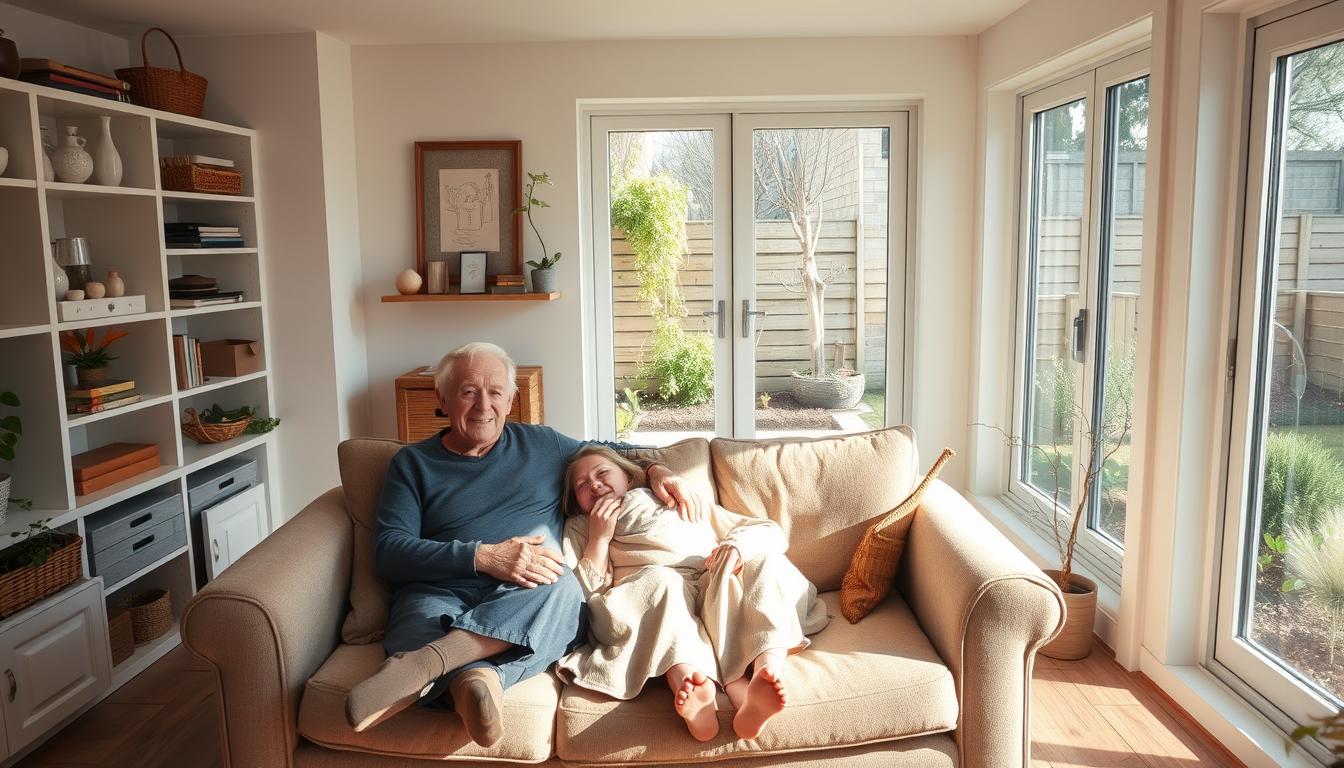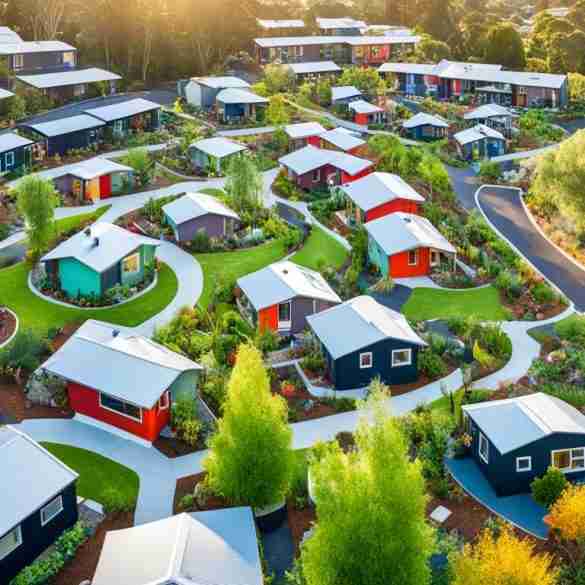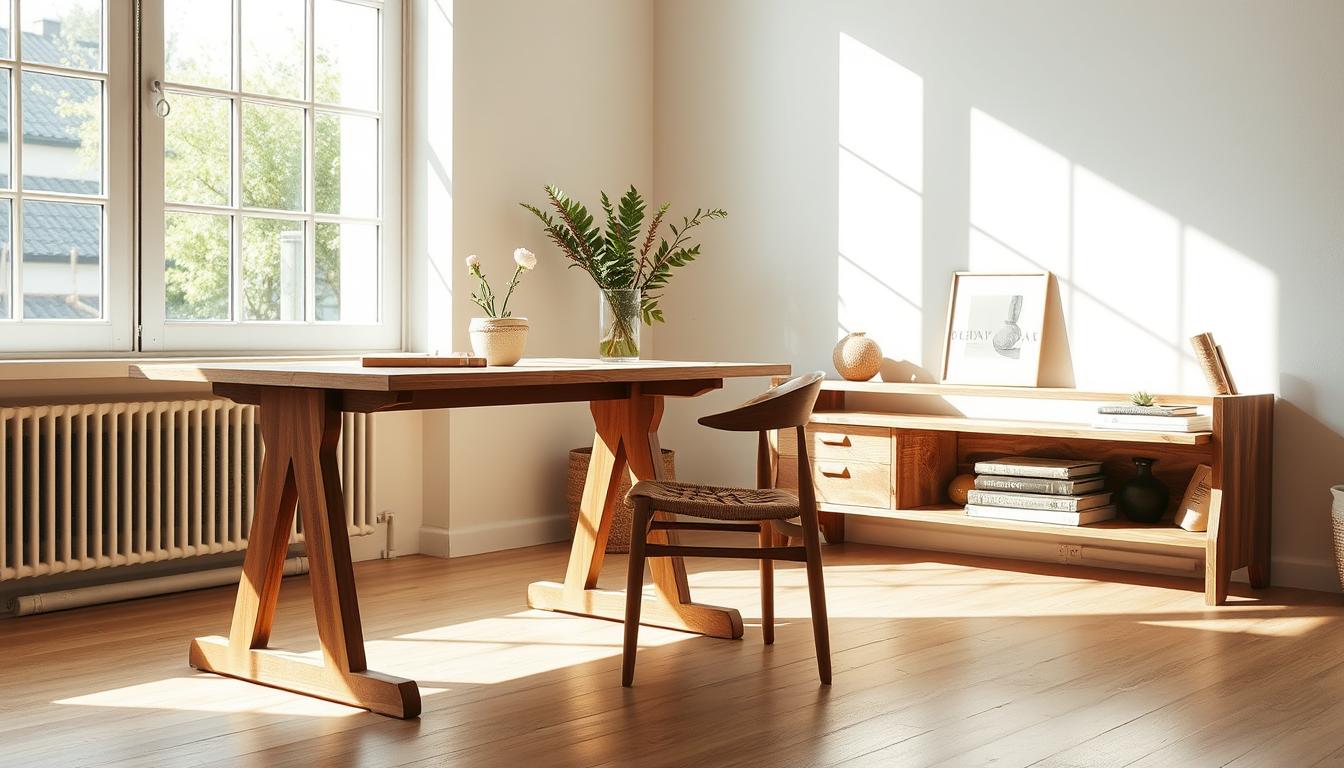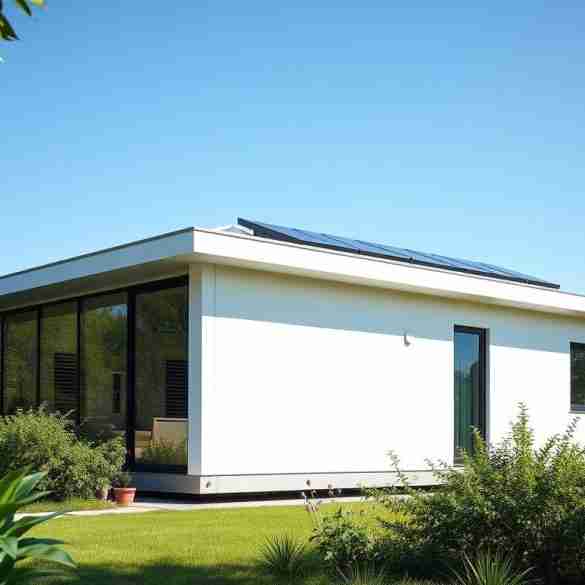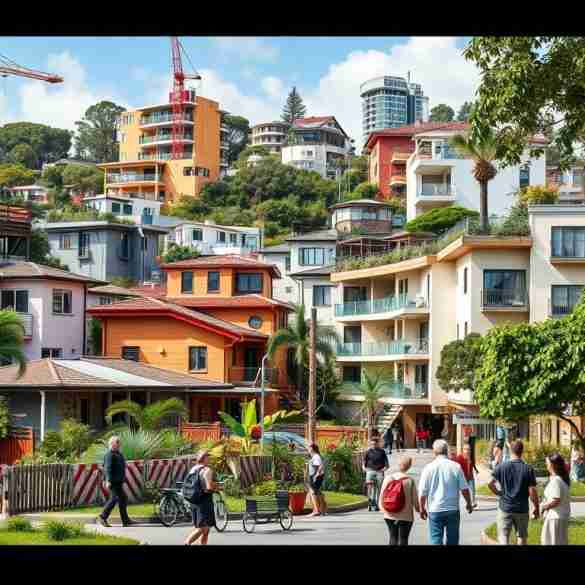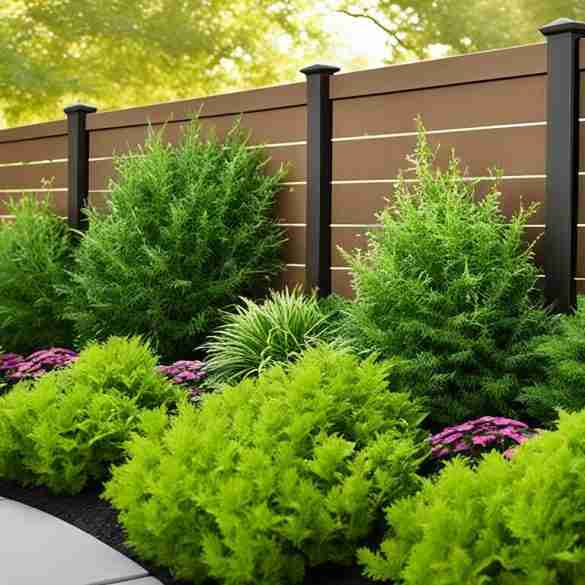When designing modular homes in Queensland, it’s key to think about the area’s different climates. Queensland has many landscapes, from tropical to dry and coastal. Each one has its own environmental needs for modular homes.
Ecoliv is a top name in sustainable prefab modular homes. They make homes that fit Australia’s many climates. Their designs are all about saving energy and keeping people comfortable. They consider things like the seasons, sun direction, and humidity to make sure your home does well where you live.
Key Takeaways
- Queensland’s diverse climate zones require specialized modular home design considerations.
- Climate-responsive design maximizes energy efficiency and occupant comfort in modular homes.
- Factors like seasonality, solar pathing, and humidity patterns must be accounted for in modular home design.
- Ecoliv’s expertise in sustainable prefab modular homes ensures tailored solutions for Queensland’s varied climates.
- Understanding regional climate challenges is crucial for designing successful modular homes in Queensland.
Understanding Queensland’s Diverse Climate Zones
Queensland is known for its beauty and diverse climate zones. Each zone has its own challenges for building homes. Knowing about Queensland’s climate is key for designing homes.
The Coastal Climate
The coastal areas of Queensland have a warm, humid climate. They have hot summers and mild winters. Homes here need good ventilation and insulation to stay cool.
The Dry Interior
The interior of Queensland is hot and dry. It’s called the Outback. Homes here need to keep cool and use less energy.
The Tropical North
The north of Queensland is very hot and humid. It’s important to keep homes cool and dry in this area.
The Nationwide House Energy Rating Scheme (NatHERS) helps design homes for Queensland’s climate. It checks if homes use energy well. It helps choose the best insulation and ventilation.
| Climate Zone | Temperature Range | Humidity Levels | Design Considerations |
|---|---|---|---|
| Coastal | Warm Summers, Mild Winters | High Humidity | Effective Cooling, Insulation |
| Dry Interior | Hot Summers, Warm Winters | Low Humidity | Minimizing Cooling Needs, Energy Efficiency |
| Tropical North | Hot, Humid Summers, Warm, Wet Winters | High Humidity | Tropical Modular Home Ventilation, Humidity Management |
Knowing Queensland’s climate helps build homes that last. It’s important for Queensland modular home insulation and tropical modular home ventilation.
Key Climate Challenges for Modular Homes
Queensland’s climate is varied, posing challenges for building modular homes. These homes need to handle extreme weather, big temperature changes, and constant humidity. It’s key to make them durable, comfy, and green.
Extreme Weather Events
Queensland faces severe weather like cyclones, hailstorms, and floods. The 1999 Sydney hailstorm caused over $3.3 billion in damage. The 2010-11 floods in Brisbane, Victoria, and Tasmania cost $5.6 billion.
Cyclone Yasi in 2011 caused $3.5 billion in damage. A direct hit on Cairns could cost between $1.5 billion and $8 billion. It’s vital to build homes that can stand up to these storms.
Temperature Fluctuations
Queensland’s temperature changes a lot, warming by about 0.8°C since 1910. This has made air-conditioning use go up, doubling electricity costs for the building industry. Homes need to handle these changes well to stay comfy and save energy.
Humidity and Moisture Issues
Queensland’s high humidity and moisture can cause mold, mildew, and damage. Homes need good ventilation and moisture-resistant materials to fight these problems.
Building homes for Queensland’s climate needs a deep understanding of the local weather. By tackling these challenges, homes can be comfy, green, and strong all year.
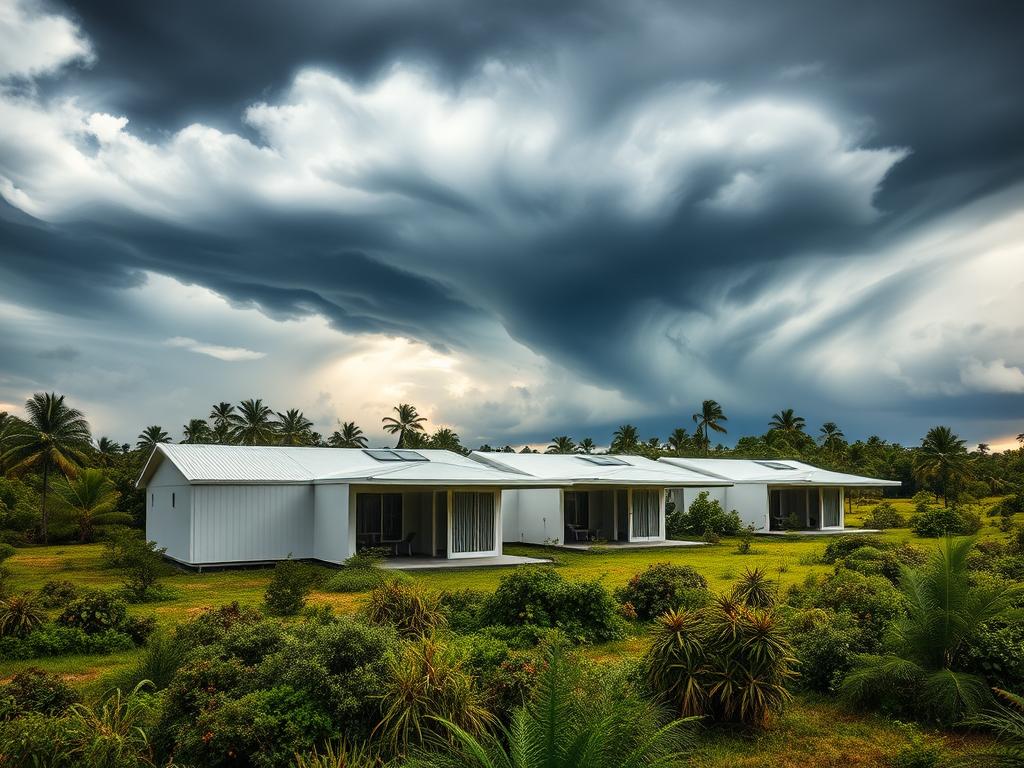
“Climate-responsive architecture not only reduces energy consumption but also enhances environmental sustainability, lowers operating costs, and improves occupant comfort levels.”
Designing for Heat Management
Living in Queensland means dealing with a lot of heat. To manage this, you need good insulation, smart ventilation, and the right solar orientation.
Insulation Techniques
Insulation keeps your home cool and saves money on heating and cooling. Use materials like reflective foil and polyurethane to keep your home warm in winter and cool in summer. Place insulation in walls, ceilings, and floors to block heat.
Ventilation Strategies
Good ventilation is key in Queensland’s humid weather. Use windows and fans to keep air moving and prevent moisture. High ceilings and louvered windows help too.
Solar Orientation
Getting natural light without too much heat is important. Arrange your home to catch the sun’s rays right. This makes your home more energy-efficient and bright.
Using these strategies, your Queensland home can be comfy and save energy. Sustainable Home Magazine has tips to help you achieve this.
Storm-Proofing Your Modular Home
Building a cyclone-resistant modular home in Queensland needs careful planning. You must use durable, weather-resistant materials and add strong structural reinforcements. The roof design is key to keeping your home safe during intense storms.
Choosing the Right Materials
Choosing the right materials is crucial for storm-proofing your home. Colorbond metal roofing is a top choice. It looks good and keeps your home cool with its reflective coatings. Lighter roof colors help reflect heat better in warm areas.
Implementing Structural Reinforcements
For a bushfire-safe home, strong structure is vital. Use materials like reinforced concrete or high-strength steel for the frame, walls, and foundations. This makes your home more resilient against cyclones.
Roof Design Considerations
The roof design is critical for storm-proofing. A strong, secure roof can handle high winds and heavy rain. Features like well-anchored roof trusses and impact-resistant materials are important. Proper water drainage is also key.
By using durable materials, adding strategic reinforcements, and designing a strong roof, you can make a cyclone-resistant home. This will keep your family safe in Queensland’s extreme weather.
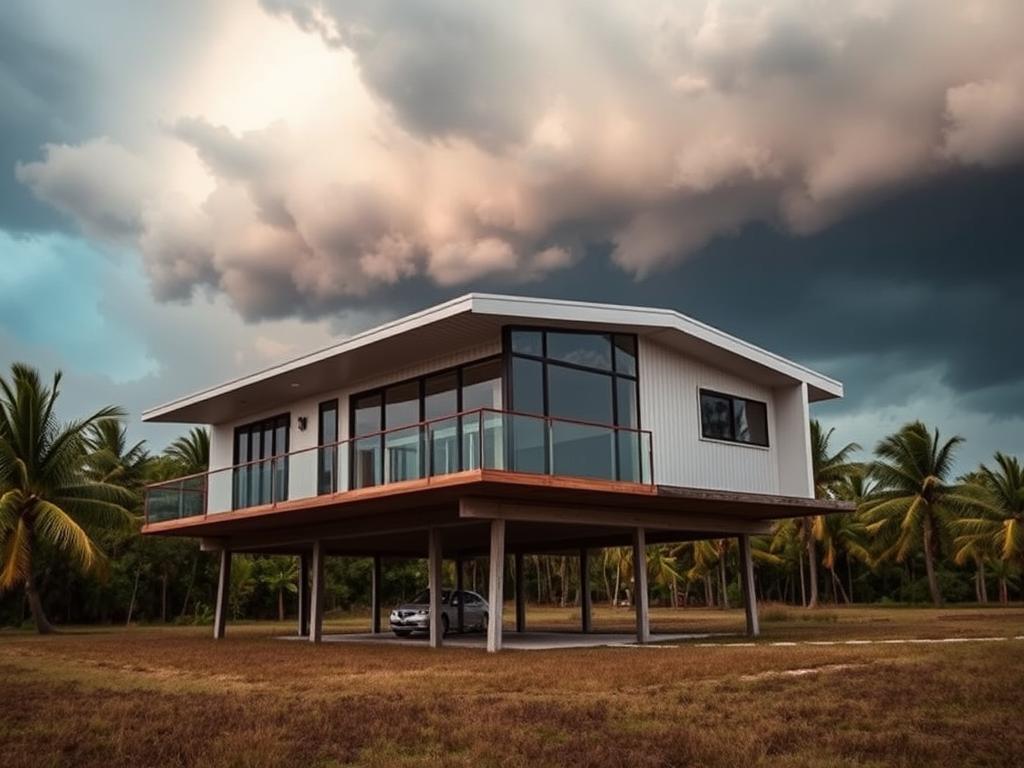
“Resilient building practices are essential for ensuring the long-term safety and sustainability of modular homes in Queensland’s challenging climate.” – Sustainable Home Magazine
Flood Risks and Mitigation Strategies
Building flood-resilient modular homes in Queensland needs a careful plan. You must pick the right site and elevation. Also, use water-resistant materials and good drainage.
Site Selection and Elevation
When picking a spot for your modular home in Queensland, check the flood risk. Stay away from places that flood often. Choose higher spots that don’t flood as much. Sustainable Home Magazine says do your homework on local floods and talk to experts.
Water-Resistant Materials
It’s key to use the right materials for your modular home in flood areas. Go for materials that resist water and moisture. This includes:
- Concrete or masonry foundations
- Waterproof membranes and sealants
- Flood-resistant insulation
- Corrosion-resistant metal framing
- Moisture-resistant drywall or sheathing
These materials help your home stand up to floodwaters and cut down water damage risk.
Drainage Solutions
Good drainage is vital for flood protection in Queensland. Use systems like:
- Perimeter drains to keep water away from the foundation
- Elevated floor systems to let water flow under the home
- Sump pumps to remove water
- Swales and retention ponds to handle extra water
These solutions help keep water away from your home and lower flood risk.
By using these strategies in your modular home in Queensland, you make it stronger against floods. This keeps your home safe and sustainable for years.
| Flood Mitigation Strategies | Key Considerations |
|---|---|
| Site Selection and Elevation | Avoid flood-prone areas, choose higher elevations |
| Water-Resistant Materials | Use concrete, masonry, waterproof membranes, and corrosion-resistant materials |
| Drainage Solutions | Implement perimeter drains, elevated floors, sump pumps, and water management features |
“Constructing flood-resilient modular homes in Queensland is essential for ensuring the long-term sustainability and safety of these structures in the face of the region’s susceptibility to flooding.”
Energy Efficiency in Queensland’s Climate
Queensland is moving towards energy-efficient homes. They use solar power and follow passive design. This helps cut down on carbon emissions and lowers energy costs.
Solar Power Integration
Solar panels are changing the game for homes in Queensland. They let homeowners make their own energy. This cuts down on grid use and helps the environment.
It also helps with rising energy costs. Queensland aims to reduce greenhouse gas emissions.
Energy-Efficient Appliances
Choosing the right appliances is key for sustainable homes. High-efficiency fridges and lights save energy. This reduces environmental impact.
By making smart choices, homeowners enjoy modern comforts. They also support the sustainability movement.
Passive Design Principles
Passive design is vital for energy-efficient homes in Queensland. It includes natural ventilation and smart window placement. This keeps homes cool without using much energy.
By using the climate and local resources, homes are eco-friendly. They fit well with Queensland’s unique conditions.
Using solar power, efficient appliances, and passive design is important. It makes homes more sustainable. Homeowners help their communities become greener.
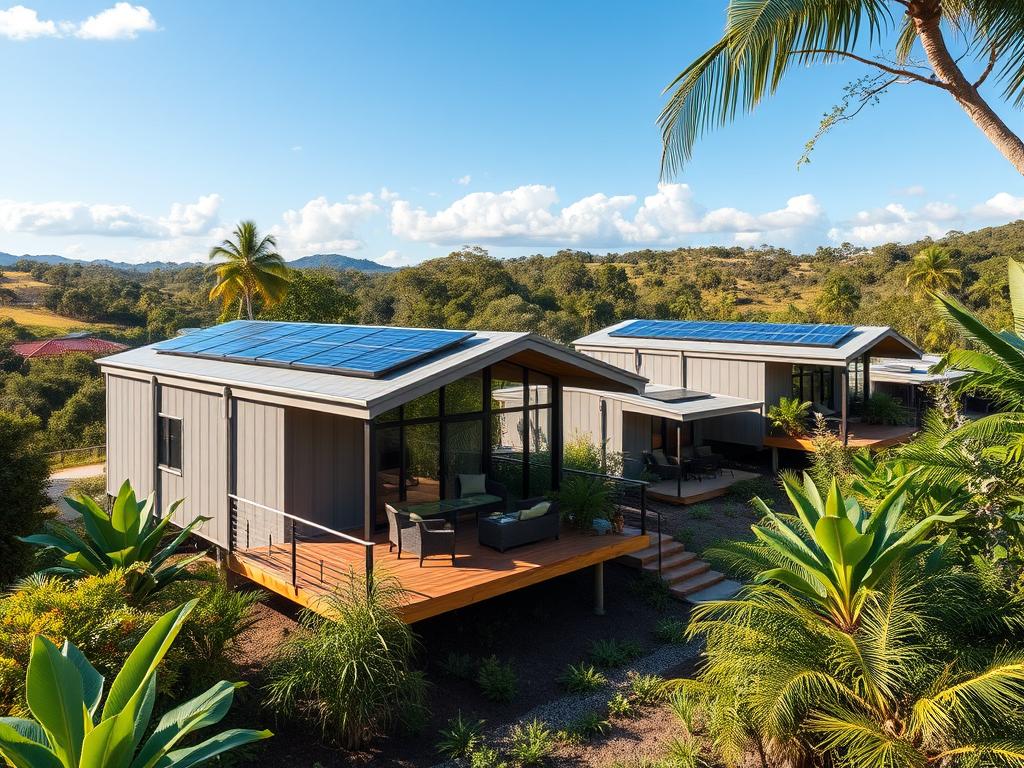
Importance of Local Building Codes
When it comes to modular home design Queensland, following local building codes is key. These rules make sure your home is safe and strong. They also consider your area’s weather.
Knowing and following these codes is vital. It makes sure your home is legal and fits well with the environment.
Understanding Regulations
Modular homes in Queensland must follow local, state, and federal codes. These rules cover many things like safety and energy use. They also make sure your home is easy to get around.
By knowing these rules, you can make sure your home is safe and comfy. It will last a long time and be a good place to live.
Compliance with Climate Considerations
Modular homes also need to handle your area’s weather. This means they must be weatherproof and keep the right temperature. They also need to be strong against storms.
Working with local authorities helps make sure your home is ready for Queensland’s weather. This way, your home will be safe and comfortable for years.
| Regulation | Description | Relevance |
|---|---|---|
| National Construction Code (NCC) | Sets the minimum requirements for safety, health, and sustainability in Australian buildings. | Establishes the baseline for modular home design and construction in Queensland. |
| Bushfire Attack Level (BAL) | Classification system for construction in bushfire-prone areas, ranging from BAL low to BAL FZ. | Ensures modular homes in high-risk regions are built to withstand bushfire events. |
| State-Specific Guidelines | Detailed regulations and requirements for each Australian state and territory. | Addresses the unique climate and environmental factors of the Queensland region. |
By following these local building codes, you can make sure your modular home design Queensland is safe and strong. It will also be ready for your area’s weather.
“Regulations post-Royal Commission are focusing on constructing homes with a better chance of withstanding fire events.”
Sustainable Practices for Modular Homes
Modular homes are getting more popular in Queensland. It’s important to think about how to make them sustainable. This includes using green materials, reducing waste, and creating landscapes that can handle the weather.
Green Building Materials
Building modular homes is a chance to use eco-friendly materials. Think recycled steel, bamboo floors, and insulation from sheep’s wool or cellulose. Using green building materials helps reduce harm to the environment. It makes the homes more sustainable in Queensland.
Waste Reduction Strategies
Modular homes make less waste than traditional building. This is because they are built in a factory. This way, materials are used more efficiently, cutting down on waste.
Builders can also recycle, donate, or find new uses for leftover materials. This makes their homes even greener.
Landscaping for Climate Resilience
The landscape around a modular home is key to its sustainability in Queensland. Using plants that don’t need much water and trees for shade helps. Good drainage systems also play a part.
These steps make the home’s landscape more resilient to the weather. It also helps with energy use and water management.
By focusing on sustainability, modular homes can lead the way in Queensland. Using green building materials, reducing waste, and creating durable landscapes makes homes better for the environment. It also makes them fit well with the local climate and nature.
| Sustainable Feature | Benefit | Example |
|---|---|---|
| Recycled Steel Framing | Reduced environmental impact, improved durability | Modular homes in Queensland can use recycled steel frames. These are stronger and need less energy to make than regular frames. |
| Bamboo Flooring | Renewable, durable, and low-maintenance | Bamboo is a fast-growing, sustainable choice for flooring. It looks good and lasts a long time. |
| Drought-Tolerant Landscaping | Reduced water consumption, enhanced climate resilience | Using plants that don’t need much water helps save water. It also makes the home more resilient to the weather. |
Sustainable practices in modular home construction can make a significant impact on reducing the environmental footprint of the building industry in Queensland.
By using sustainable methods, builders and owners in Queensland can help the environment. They can make homes that are good for the planet and can handle the weather.
Choosing the Right Location
When picking a spot for your modular home in Queensland, think about how it affects energy use, weather resistance, and green living. You should look at three main things: how close it is to services, the environmental risks, and what the community and lifestyle are like.
Proximity to Services and Infrastructure
Choosing a spot near important services makes your home more livable. Think about how close it is to hospitals, schools, shops, and public transport. Being close to these can really improve your daily life.
Assessing Environmental Risks
It’s key to check the environmental risks of your location. Look at flood risks, bushfire dangers, and how climate change might affect it. This helps make sure your home can handle Queensland’s varied weather.
Community and Lifestyle Considerations
The community and lifestyle around your home matter a lot too. Think about the local culture, fun activities, and the area’s quality of life. This helps find a spot that fits your lifestyle and preferences.
By thinking about these factors, you can pick a great spot for your modular home in Queensland. The right place can make your home sustainable, strong, and cozy.
“Sustainability is not just about the environment – it’s also about creating communities that are inclusive, diverse, and vibrant. The location of your modular home plays a crucial role in achieving that balance.” – Sustainable Home Magazine
Maintenance Tips for Modular Homes in Queensland
Maintaining modular homes in Queensland’s climate needs care and planning. Get ready for the seasons and check your home often. This keeps your home strong, energy-smart, and ready for anything.
Preparing for Seasonal Changes
Queensland’s weather changes a lot. Make sure your home is ready. Before the rain, check your drains to keep water out. Adjust your shades to block the sun in summer.
Also, watch for storm damage and fix it fast. This keeps your home safe and sound.
Regular Inspections and Repairs
Keeping up with your home is important. Check your insulation, vents, and seals often. Fix small problems early to save money and keep your home running well.
| Maintenance Task | Frequency | Benefits |
|---|---|---|
| Check insulation integrity | Annually | Maintains thermal comfort and energy efficiency |
| Inspect ventilation systems | Bi-annually | Ensures proper airflow and indoor air quality |
| Evaluate weather sealing | Annually | Prevents air leaks and drafts, reducing energy costs |
Stay on top of maintenance to keep your home in top shape. This way, your modular home will last long and work well in Queensland’s weather.
“Proper sealing can help maintain a stable indoor temperature regardless of external weather conditions, improving thermal comfort.”
Keeping up with maintenance and adjusting for the seasons is key. It helps your modular home last longer and work better in Queensland’s weather. Follow these tips to enjoy your home’s benefits for many years.
Future Climate Projections for Queensland
When planning your climate-responsive modular home in Queensland, think about the future climate. The state will likely face more extreme weather, like hotter days and changes in rain. This means your home needs to be ready for these changes.
Anticipated Changes in Weather Patterns
Climate models show Queensland will see more days over 35°C. The state’s rain levels might change too. Some areas could get less rain, while others might get more. Your home should be designed to handle these weather shifts.
Long-Term Planning for Resilience
To keep your modular home comfortable and strong, plan for the future. You might need better storm protection, cooling systems for hot days, and ways to save water. This way, your home will be ready for Queensland’s changing weather.

